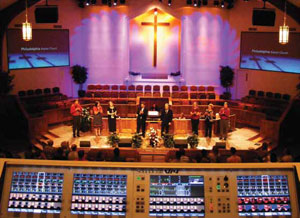Successful Sales Proposal Strategies in the Worship Market are all About Managing Expectations
After the new central cluster and a Soundcraft Si4 were installed in The Philadelphia Baptist Church of Deville, LA, Current Design in Acoustics of Rustin, LA installed five Bag End PD18E-AD powered dual 18-inch subwoofers with a Bag End Infra MXB integrator.
As those who service the house of worship (HOW) market already know, trying to coordinate the needs of committees, administration, worship leadership, and technical departments is no small feat. The structural make-up of churches, however, is unlikely to change anytime soon, which begs the question: how do systems contractors get through all the red tape?
Vance Breshears, director and principal at Acoustic Dimensions, an acoustical design firm headquartered in Dallas, TX, mused that the engineering part of this business is the easy part; negotiating with people is the real challenge. With churches, this can become more of an issue when committee members have conflicting ideas on what should comprise an AV integration project. In these situations, it’s up to the systems integrator to find some common ground. “If you have conflicting ideas amongst the people on the committee, it’s a matter of drawing those people out,” he said. “It’s a matter of focusing on goals. What are the common goals? What do you have to do to get there? When you take that approach, the issues are alleviated to some degree.”
One of the main challenges associated with selling to churches is that committee members have unrealistic ideas about the cost of professional-grade equipment. “You go in, and they are thinking it will cost $50,000, while you know that if we are talking about professional equipment, it could be a $1 million project for what they want to do,” said Gary Stigall, chief technology officer at TV Magic, a systems integration firm based in San Diego, CA . To avoid this, systems integrators should attempt to determine the church’s budget at the very beginning of the discussion—if possible. “Sometimes, they are reluctant to reveal the budget because they are afraid that you will fill the budget with unnecessary items to use every last dollar that they have.” To gain the committee’s trust, he suggests that systems integrators demonstrate the results of previous, similar projects.
Breshears noted that discussions involving price call for diligent management of the client’s expectations. “We often get funny looks and frustration when clients find out how much something costs, like we’re making it expensive,” he explained. “My approach is to show them options and associated features along with the cost, and let them decide.” This requires a willingness on the part of the systems integrator to educate the church committee on the features offered by professional equipment. “You need to explain that if they want certain features and capabilities, they have to pay for them. It’s a matter of aligning those expectations with what the real costs are going to be.”
Carolyn Heinze is a freelance writer/editor.
HOW to Fix a Budget
One of the most significant challenges involved in selling to churches—as is the case with most other markets—is working within budget limitations. To achieve this, Gary Stigall, chief technology officer at TV Magic in San Diego, CA, favors dividing AV integration projects into several stages. “We try to convince our clients to accept a multi-phase integration process wherein they pay for design services first, then installation last—much like you would do when constructing a large building,” he said.
He admits that sometimes this can be a hard sell, since clients want the ability to budget a fixed cost. “While we can estimate this charge, it’s usually only after they have lived through it that clients see the value in the design, then the build process.”
However, he added, if systems contractors can gain the trust of prospective church clients by referring them to previous installation projects, this can be an effective method of addressing both the budget, and the client’s expectations.
—Carolyn Heinze










